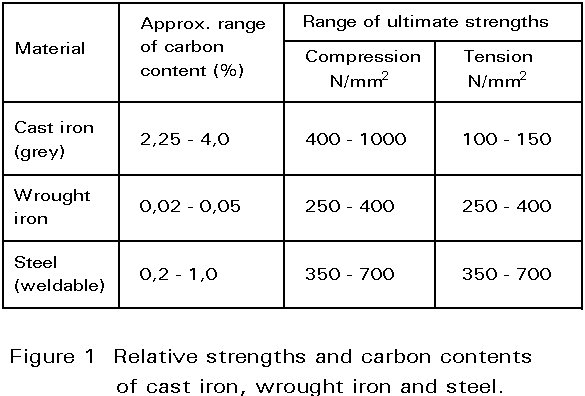
ESDEP WG 1B
STEEL CONSTRUCTION:
INTRODUCTION TO DESIGN
To appreciate how steel became the dominant structural material that it is today, it is essential to understand how it relates to cast iron and to wrought iron, both in its properties and in the way that all three materials evolved.
None.
Lecture 1A.2: Steelmaking and Steel Products
The properties of the three ferrous metals, cast iron, wrought iron, and steel, are described and the evolution of their production is summarized. The evolution of their structural use is also given and the prospects for further development introduced.
Cast iron, as the name implies, is "cast" or shaped by pouring molten metal into a mould and letting it solidify; a wide variety of often very intricate forms is thus possible. It is very strong in compression, relatively weak in tension, much stiffer than timber, but brittle.
Wrought iron is strong both in tension and compression and ductile, thus making it a much safer material for beams than cast iron. Its main disadvantage is that, never reaching a fully molten state, it can only be shaped by rolling or forging, thus limiting its possible structural and decorative forms.
The properties of mild steel are similar to those of wrought iron but it is generally stronger and can be cast as well as rolled. However, it has a lower resistance to corrosion than wrought iron and is less malleable and thus not so suitable for working into elegant, flowing shapes.
These properties, in terms of strength and carbon content, are shown in Figure 1; the values shown should be considered as indicative rather than absolute limits. They do not include malleable or ductile cast irons which have strengths in tension considerably above those shown.

Iron has been known and used for more than three thousand years, but it was not until the development of the blast furnace around 1500 AD that it could be produced in molten form. In China, molten iron goes back much earlier but this is not generally thought to have been known in the Western World until well after the independent invention of the blast furnace. There is slender evidence that the Romans knew how to produce cast iron but, if they did, the knowledge was certainly lost.
Before the blast furnace, iron was extracted from ore by chemical reduction in simple furnaces or hearths. Inevitably, the scale of the operation was small and the process quite laborious, the iron coming in a hard pasty form, far from liquid, which was then refined and shaped by hammering. Essentially, this was 'blacksmith's iron'.
Although possible in the 16th Century, molten or cast iron was hard to produce on a large scale before the change from charcoal as a fuel to coke. With charcoal, the practical size of furnace was limited by the crushing of the fuel by the weight of the charge of the ore and thus the stifling of the blast. Abraham Darby I is generally credited with the mastery of coke smelting and, even though this was in 1709, coke smelting did not dominate the industry until about 1750 in Britain and considerably later in other parts of Europe.
Large scale wrought iron, as opposed to blacksmith's iron, became possible mainly as a result of the developments culminating in Henry Cort's puddling furnace patented in 1793. In this furnace, the carbon in cast pig iron was burnt off in a reverbatory furnace while the impurities were drawn off by 'puddling'. As the process continued and the iron became purer, its melting point rose and the furnace charge became more viscous, eventually being removed in a stiff plastic form for rolling or forging. It was the enlarged scale of the operation which was significant rather than any change in the actual material which was effectively the same as the blacksmith's variety.
The modernising of wrought iron depended not only on the puddling process, but the idea of grooved rollers which made possible the economic production of angle and tee sections, and later channels and joists. Here again, Henry Cort, who patented the grooved rollers in 1784, gets the credit although the due financial rewards eluded him.
Although steel-type iron had existed for many centuries, steel as used today dates from the 18th Century. It was produced either by cementation, a process by which bars of pure wrought iron absorbed carbon during prolonged heat treatment, or after about 1750 in molten form by Hunsman's crucible process. Cementation was largely confined to the cutlery and tool trades and has no real relevance to construction. Crucible steel continued to be made, although at a decreasing level of production, until after the Second World War; however it is uncertain how much of this was used structurally in construction works.
It is a common fallacy that the use of steel dates from Bessemer's converter of the mid 1850s; not only did Kelly in America get there first with an almost identical process, but the amount of steel already being produced was quite substantial. Some 60,000 tons of steel were produced each year around 1850 in Britain alone which is far from negligible, except perhaps when compared with an annual world production of 2,5 million tons of iron in the same period. Bessemer's steel was certainly cheaper and could be made in larger quantities, but its quality was uncertain. It was not until the perfection of the Siemens-Martin open-hearth process in the 1880s that steel moved in a big way into the construction and shipbuilding industries.
Today, very little truly structural cast iron is being used and no wrought iron is being made. Steel is wholly dominant. There are, however, some signs of a limited revival of cast iron, particularly in the new ductile form only available since the 1940s.
In looking at the structural achievements with iron and steel in the last 250 years, it is convenient to class these in relation to the period, or age, when each of the three ferrous metals was dominant. Inevitably, these periods overlap and it is significant that in each case it took quite a long time - up to 50 years - before what was found to be possible became commercially widespread. The periods are broadly as follows:
Cast Iron Period 1780-1850 (Columns up to 1900)
Wrought Iron Period 1850-1900
Steel Period 1880 - Present Day
These dates are essentially based on Britain where the iron industry was more developed in the first half of the 19th Century than elsewhere. In France, there was no real cast iron period, while in America both cast iron and wrought iron were comparatively little used before the middle of the 19th Century, after which there was a positive explosion in their application. Steel on the other hand, became popular at roughly the same time throughout Europe and America. Figure 2 emphasises how short the overall period of structural use of iron and steel has been in relation to man's knowledge of iron.
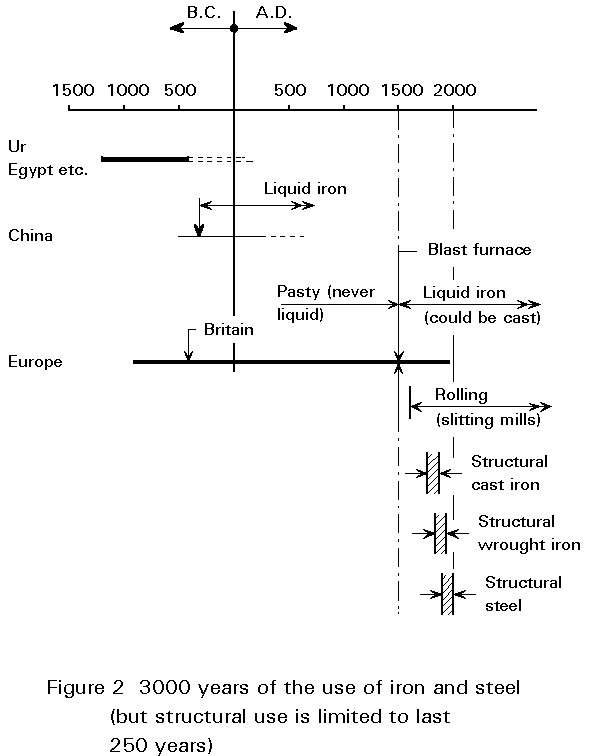
Given availability, new materials are introduced either for greater economy or to solve specific problems.
All the early cast iron bridges were arched forms in which cast iron merely replaced masonry, the advantages being greatly reduced weight and horizontal thrust, economy and speed of erection. The first iron bridge of any magnitude was the famous Coalbrookdale one completed in 1779 and spanning some 33 metres (Slide 1), a structure full of apparent illogicalities mixing carpenter's and mason's detailing but still standing proudly today. The construction of this bridge was followed by a whole succession of cast iron arch bridges in Britain, including Thomas Wilson's Wear Bridge of 1792-6 with wrought iron strapping to the cast voussoirs and a span of 72 metres (Slide 2) and Rennie's Southwark Bridge of 73 metre span completed in 1819. The climax, but by no means the last, cast iron bridge, was perhaps Telford's Mythe Bridge at Tewkesbury (1823-26) with a span of only 52 metres but great lightness and total structural logic (Slide 3).
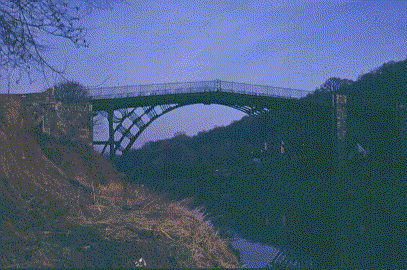
Slide 1
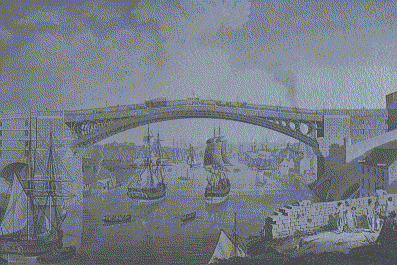
Slide 2
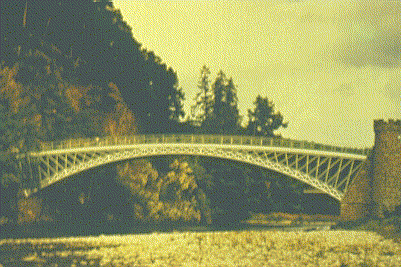
Slide 3
In other parts of Europe, cast iron arch bridges were a rarity until well into the 19th Century, the number of schemes greatly exceeding the number built. Le Pont des Arts in Paris of 1801-3 by Cessart was, perhaps, the most famous, now, alas, replaced by a not wholly convincing welded lookalike. There were several early cast iron arch bridges in Russia.
With all buildings, fire was a recurring problem with timber structures. It was almost certainly the reason for one very early application of cast iron, the columns supporting the vast cooker hood and chimney of 1752 at the Monastery of Alcobaca in Portugal. In Britain, cast iron was used in the early 1770s in churches, partly for the cheap reproduction of Gothic ornament, but also for structural columns. In Russia architectural cast iron was used extensively throughout the 18th Century but it is not clear to what extent it was also used to support floors and roofs.
It is hard to see any trend arising from these early applications of iron to buildings. It was in the multi-storey textile mills in Britain in the 1790s that cast iron was first shown to have a major future in building structures. The disastrous fire at Albion Mill in 1791 was perhaps the biggest incentive for change. Bage and Strutt were the great pioneers. Between them, they developed totally incombustible interiors in cast iron and brick but with floor spans still of only about 2,5 to 3,0 metres in each direction, as had been the case with timber interiors. Later, this iron mill construction spread to warehouses with a gradual increase of spans.
While fire was the main reason for change in the mills, there was a growing desire in public buildings and large houses for long-span floors which did not sag or bounce. Timber had generally proved inadequate for spans above 6-7 metres. Between about 1810 and the early 1840s there was an increasing interest in cast iron floor beams, some with spans of 12 metres or more such as those in the British Museum of the early 1820s (Figure 3). Sometimes these castings were used as simple substitutes for the main timbers in essentially timber flooring, but in other cases brick jack arches, as in the mills of around 1800, or stone slabs were combined with long span cast iron beams to give rigidity, sound insulation and fire protection. Another form of 'fire proofing' consisted of wrought iron plates within the ceiling space arching between the cast iron beams. The climax of the development of cast iron flooring was reached in Barry's Palace of Westminster of the 1840s. Up to the mid 1840s, cast iron was seen as the wonder material everyone was looking for.

It is tantalising how little is known about who actually fixed the size and shape of the beams used by Nash, Barry and other architects of this period. Thomas Tredgold's book on cast iron of 1824 was undoubtedly influential but dangerously in error in some respects. In most cases, it is probable that proof-loading of beams, which was widely used, provided the main safeguard against misconceptions and poor workmanship.
Apart from the mills and the long span floors, there was a whole range of new uses of cast iron between 1810 and 1840, sometimes on its own for complete structures as in Hungerford Market of 1836, or Bunning's highly decorated Coal Exchange of 1847-49. In Russia, there was also a considerable quantity of cast iron building construction in the first half of the 19th Century, as in the Alexandrinsky theatre of 1829-32 and the Dome of St Isaacs Cathedral (1837-41).
Towards the close of the 1840s, cast iron had lost much of its golden image and was being seen as an unreliable material, especially for beams. The progressive collapse of five storeys of Radcliffe's Mill in Oldham in 1844 and the failure of the Dee Bridge in 1847 were both highly damaging to its image.
Not all iron in the 'cast iron period' was cast. Some of it was composite cast and wrought iron and some simply wrought iron. There is little evidence of steel being used structurally in this period.
In Britain, cast iron was sometimes used in combination with timber as at New Tobacco Dock of 1811-14 or with wrought iron, as in the 1837 roof at Euston Station (Slide 4).
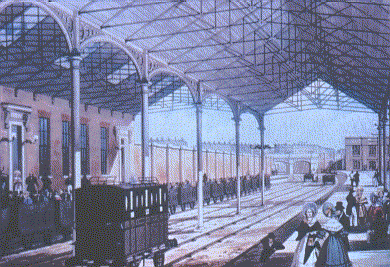
Slide 4
After 1840, the scale of iron construction and the proportion of wrought to cast iron in composite structures, increased substantially. The Palm House at Kew 1844-47, by Richard Turner and Decimus Burton, was a marked advance on earlier glasshouses and arguably incorporates the world's first rolled I sections. Wrought iron roofs of increasing span on cast iron columns proliferated both in the naval dockyards and for railway stations culminating in Turner's roof of 47 metres span at Lime Street, Liverpool (1849).
In France, some highly innovative wrought iron floors and roofs had been built before the Revolution, such as Victor Louis's 21 metre span roof of 1786 at the Palais Royal Theatre in Paris (Figure 4). In this roof, as in the case of the bridge at Coalbrookdale, the structural logic is not altogether clear. However, the flooring system of arched wrought iron flats devised by M. Ango in the 1780s (Figure 5) is clearly understandable and derivatives of this system continued in use until they were largely replaced by a number of 'fire-proof' systems, still based on wrought iron, in the late 1840s. Cast iron impinged in France to quite an extent in the 1830s and after, notably in the great iron roof of 1837-38 at Chartres Cathedral and the Bibliotheque St Genevieve 1843-50, but it seems that wrought iron always retained its dominance.
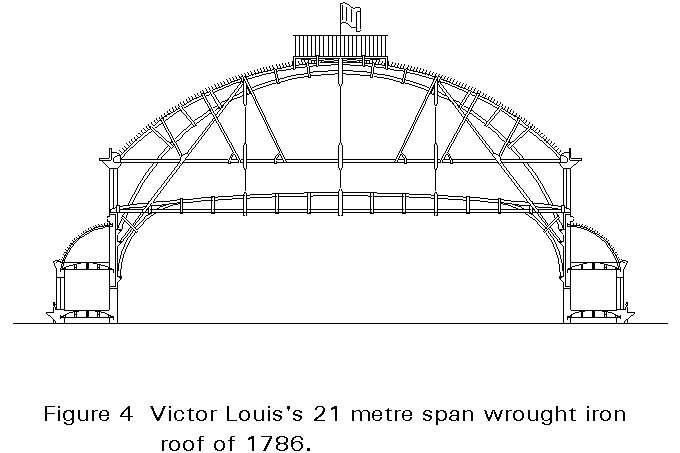
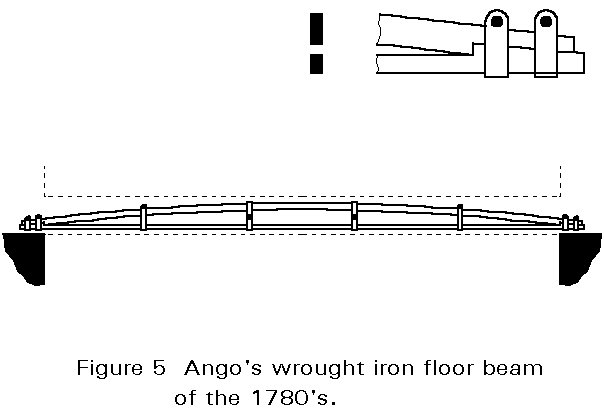
Composite construction featured quite widely in Russia. In St Petersburg, a form of riveted plate girder was devised in 1838 for the repair of the Winter Palace after the fire of 1837. This development was just ten years before the independent development of riveted wrought iron beams in Britain.
Some of the most creative work on the suspension bridge dates from the 'cast iron period' but is wholly related to wrought iron, although Tredgold did have the temerity to suggest cast iron support cables. In most fields of construction, America clung to timber rather than iron in the first half of the 19th Century, but must be given credit for introducing the level deck suspension bridge, as patented by James Finley in 1808 with wrought iron chassis (Slide 5). Thereafter, there was a minor battle of principles on the form of cable. Britain favoured wrought iron chains with eye-bar links, as had Finley, while the French preferred wire cables, the difference being largely due to the states of the iron industries in the two countries.

Slide 5
By 1850, France had built several hundred suspension bridges, mainly due to the enterprise of the Seguin brothers, while Britain could claim scarcely more than a dozen. If the French had confined the wires to the sections of the cables above ground, all might have been well, but they did not. Corrosion became a major problem brought to a head by the collapse in 1850 of the Basse-Chaine suspension bridge with a death toll of 226. Thereafter, substantial remedial works followed and the building of suspension bridges all but stopped in France for many years. Nevertheless, based on French influence, wire cables did take over from eye bar chains in America and became virtually standard throughout the world.
The wrought iron period was primarily the period of the riveted wrought iron beam which dates from the late 1840s, although by then wrought iron had established a fairly firm position in composite construction. Seen in the long term, wrought iron beams owe their birth, in part, to growing doubts both on the safety of cast iron in bending and in part to successful experience with iron ships. However, by far the biggest single contribution, not only to the development of riveted beams, but to the whole establishment of wrought iron as the dominant material of the period, was the design and construction of the Britannia and Conway tubular bridges, particularly the former.
The key figures here were Robert Stephenson, engineer to the Chester and Holyhead Railway; William Fairbairn, the practical man with experience of iron ships; and Eaton Hodgkinson, the theorist and experimenter.
Faced in 1845 with the then seemingly impossible task of taking trains over the Menai Straits, when shipping interests ruled out arches and suspension bridges as they had been shown to be inadequate for railway loads, they developed a new structural form, the box girder, and demonstrated it on a large enough scale for trains to run inside (Slide 6). However, it was not the bridges which mattered so much as the understanding which resulted from the crash programme of research and testing which made them possible.
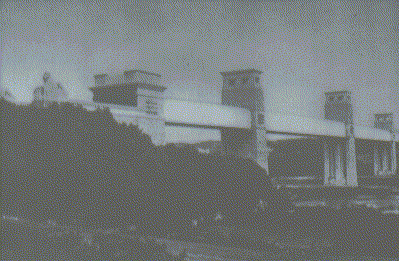
Slide 6
Between them, these three men dispelled the initial belief that wrought iron was weaker in compression than in tension, proved that a rectangular tube was stronger in bending than a circular or oval one, isolated the problem of plate buckling, and showed how to counteract this behaviour with cellular flanges and web stiffeners. Thus, these three men and their assistants established riveted wrought iron as a calculable material for beams of almost limitless size. Further, they demonstrated the benefits of continuity in beams, even for deadload (based on theoretical work from France) and proved that the strength of rivets depended on clamping as much as on dowel action. The extent of material and model testing for these bridges was prodigious.
The speed of the work was almost as remarkable as the result. The problem of crossing the Menai straits was posed early in 1845, the Conway Bridge was opened in December 1848 and the Britannia Bridge in March 1850. In both cases, work on the supporting masonry started in the spring of 1846 well before all the problems of the spanning structures had been solved. Other smaller wrought iron bridges of the same period, with cellular compression flanges were, it seems, all spin-offs from this basic development.
It is, perhaps, worth noting that concurrently with this major innovative work, Stephenson was responsible for a mass of other railway construction, including the six-span Newcastle High Level Bridge with cast iron tied arches of 1846-49 (Slide 7) and the ill-conceived Dee Bridge at Chester based on trussed
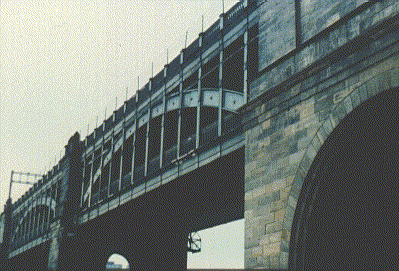
Slide 7
cast-iron beams, which collapsed disastrously in 1847 soon after it was opened. The pressure on the leaders of the engineering profession at this time are hard to imagine and it is no surprise that, sometimes, relationships became strained, as they did between Stephenson and Fairbairn.
The evolution of the plate girders of today from these beams with cellular compression flanges took place largely in the 1850s. Figure 6 shows some steps in this transformation.
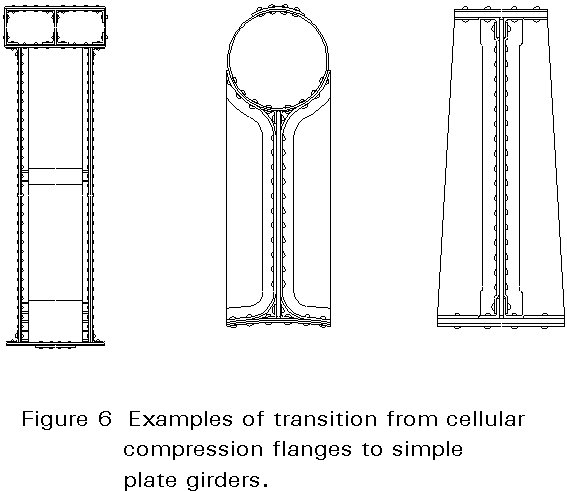
The rationalisation of truss forms and their full structural evolution is another feature of the 1850s. Many of these forms derived from timber construction in America but given riveting and wrought iron the scope opened up enormously. The Britannia Bridge has been criticised for wasting material in comparison to an equivalent structure with open trussed sides, but this is unfair when one considers how little was known about true truss action in the mid 1840s. Figures 7a and 7b show typical intuitive and mathematically rational truss forms of this period. There were many variations on these forms.
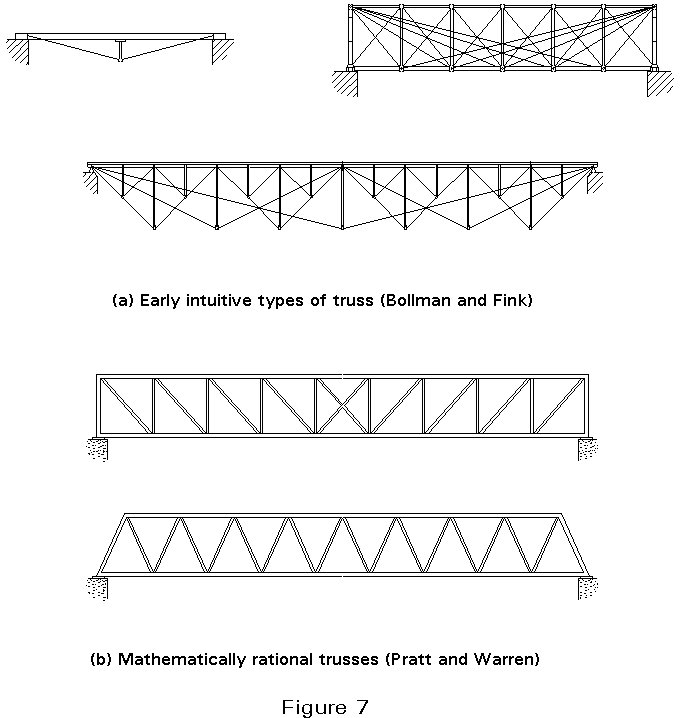
Numerous wrought iron bridges of all forms and sizes followed in all countries. In Britain, I.K. Brunel's Saltash Bridge completed in 1859 and Thomas Bouch's fatal Tay Bridge opened in 1878, stand out for very different reasons. In France, Gustave Eiffel's great arches at Oporto and Garabit, of 1875-7 and 1880-84 respectively, are now world famous. In America, Charles Ellet's Wheeling Suspension Bridge of 1847-9, Roebling's Niagara Bridge completed 1855, and James Ead's St Louis Arch Bridge of 1867-1874 are all rightly famous, although one must add that the last of these is partly of steel.
In buildings the scope for drama in the use of iron was generally more modest, the largest outlet being in flooring systems both in Britain and in other parts of Europe. It was almost certainly the development of these flooring systems in France in the late 1840s and early 1850s which provided the impetus for the commercial development of rolled joists, regardless of whether the first ones of all were rolled there or in Britain. The size of the joist sections gradually increased but until liquid steel took over, size was limited by the problems of handling large quantities of puddled iron.
Cast iron continued to be used extensively for columns well after 1850. In America there was a great vogue for cast iron facades which lasted for several decades. Bogardus and Badger were the two main suppliers. Internally, the structures vary, with iron, masonry and timber all represented.
Apart from these useful, but often unseen, applications of iron to traditional buildings, some spectacular iron build structures, mainly long span roofs, were built in all countries. Most commonly, but far from exclusively, they were over railway stations. They included the ribbed iron dome of the British Museum Reading Room (1854-57), the 73 metre wrought iron arches at St Pancras Station (1868) and the dome of the Albert Hall (1867-71). These buildings were matched in France, for instance, by the Bibliotheque National (1868), Les Halles (1854-68) and the Bon Marche Department Store (1867-78); and in America by the dome of the Capitol in Washington (1856-64).
Throughout this period most buildings, particularly those of more than one storey, depended on masonry walls for stability, whether or not the floors and roof were of iron. The route to full structural framing in iron or steel is uncertain. It is often stated that the Home Insurance Building in Chicago of 1884-85 was the first fully framed tall building which formed part of a continuing development. Perhaps the earliest example of a stiff-jointed frame was Godfrey Greene's four-storey Boat Store at Sheerness of 1858-60. The Great Exhibition Building in London of 1851 and the Chocolat Menier Factory outside Paris of 1870-71 have also been claimed for this 'first', but they both had diagonal bracing and, anyway, had no apparently direct influence on the multi-storey steel construction of today.
Steel is not only stronger than wrought iron, but being produced in a molten state made larger rolled or forged units practicable. However, it is not easy to identify which is which; for several decades, steelwork was fabricated by riveting in the same way as wrought iron and, when riveted, the two look almost exactly the same. The Forth Bridge in steel and the Eiffel Tower in wrought iron, were completed at almost exactly the same time (1889-90). Looking at them, who could tell the difference?
Figure 8 shows how steel took over in quantity from wrought iron in Britain. Figure 9 shows how the proportion of open-hearth steel increased until it had all but cornered the market by 1920. The biggest incentive for change to steel lay in the ship-building industry. Lloyds Register allowed steel plating of 4/5 the thickness of wrought iron and, by 1908, Lloyds was insisting that all steel for shipbuilding should be produced by the open-hearth process.
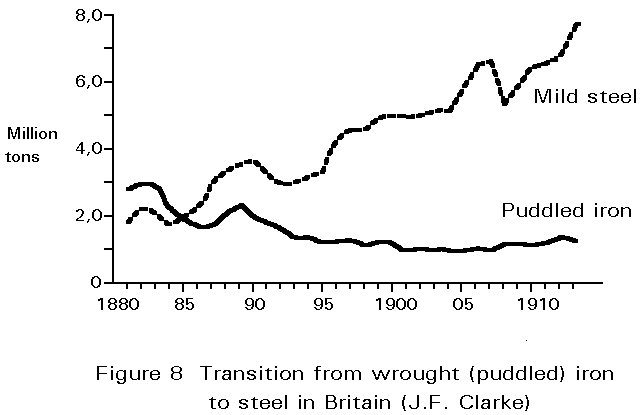

In bridges, the steel period was mainly one of increasing size and span. Here the initiative shifted away from Britain mainly to America where the need for major bridges, was greatest at this time. All the great suspension bridges up to 1945 (Golden Gate, George Washington, Transbay, etc.) were built of riveted steel with spun cables of high tensile steel wire.
In buildings the 'Skyscraper' came of age in steel, again with the initiative mainly in America. Long span roofs also took a leap in scale with steel both in France and America. First there were the great three-pin arch structures over the Philadelphia railway stations of 1893 (79 and 91 metre spans) followed by the Galerie des Machines for the 1889 Paris Exhibition of 111 metres span - over 50% up on St Pancras. These spans, in turn, have been dwarfed by the post-war domes over sports arenas. The span of the Louisiana Superdome of 1975 at 207 metres is more than 3½ times that of the Albert Hall.
The one big change in technique with steel was the introduction of welding, mainly from the 1930s, although possibly earlier. Today, the rivet is as dead as the production of wrought iron. Now welds and bolts dominate all construction in steel.
In all fields, new developments tend to follow new needs and this certainly seems to have been the case with bridges. Since the Second World War, most new thinking on suspension bridges, especially aerodynamic design and weight-saving, has been in Britain while Germany has led the field on the design of cable-stayed bridges.
One of the most noticeable moves in construction in the last ten years, in Britain certainly, but it seems elsewhere in Europe as well, has been towards a revival of structural steel for bridges and buildings. Fashions change in constructions, as in clothing, and so do needs and costs. It is, thus, interesting to look at some of the recent variants on normal structural steel and at rival materials to see how they have fared and to speculate on what may happen in the future.
Weathering steel (unpainted with stabilised corrosion) and exposed steelwork fire-proofed by water in hollow sections are both innovations of the 1960s but neither shows signs of wide adoption. On the other hand, stainless steel, although in itself much more expensive than mild steel or even high tensile steel, is being found to be increasingly worthwhile when the cost of maintenance is considered.
Plastics have yet to make any significant impact except as a protective coating or for architectural trim.
Aluminium was once thought to be a dangerous rival to structural steel but, so far, it has made little impact in bridge or building structures. Reinforced concrete - still dependent on steel - has been a strong and growing competitor of fabricated steelwork since the 1890s, largely because of its in-built fire resistance, helped in the 1950s and 1960s by an architectural desire to 'expose the structure'. This trend is now being reversed and, since 1980, there has been a vigorous rebirth of structural steel. The increasing use of structural steel has been encouraged by the pursuit of 'fast-track' construction and the realisation that reinforced concrete is not a maintenance-free material. There has also been a swing in taste from visually expressed concrete to 'high tech' styling or to the complete wrapping of buildings in glass or masonry.
Future developments with structural steel in buildings are likely to be associated with fire protection. Thin intumescent coatings which froth up when heated and form a protective layer, are becoming still thinner - more like paint - but the need for such protection may be substantially reduced by the development of fire engineering. This development could lead to a new era of exposed steelwork with increasing attention to the shape and form of members and the appearance of joints. Castings of steel or ductile iron could well be in demand once more.